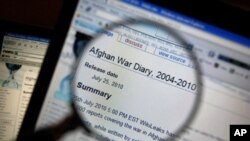The head of Wikileaks, the organization that leaked a trove of secret documents on the Afghan war, has likened the release of the documents to the leak of the Pentagon Papers 40 years ago. But under scrutiny, the analogy does not hold up.
About the only thing the two have in common is the sheer volume of documents. The Pentagon Papers was a study of U.S. policy in Vietnam composed of politically sensitive top secret documents. It exposed governmental duplicity on major policy decisions, and was a major factor in influencing public opinion on the war. The Nixon administration went all the way to the Supreme Court in an unsuccessful bid to halt their publication.
In contrast, the Wikileaks release is a collection of much less sensitive, less highly classified documents depicting a ground level view of the Afghan war. It is more like a photo album, snapshots of a war in progress.
Much of the information in the documents is raw intelligence, unverified by any analytic process. Most are classified only "secret," a relatively low level of security classification, and could have been seen by theoretically thousands of people. As one U.S. official put it to me, "Hell, secret clearances are handed out like lollipops at the dentist."
The most sensitive stuff details possible links between Pakistan's powerful InterServices Intelligence directorate, the ISI, and the Taliban. There are reports of purported meetings between ISIS officers and Taliban militants where attacks are planned. There is even an allegation of ISI collusion in a Taliban plot to assassinate Afghan President Hamid Karzai. And the name of Hamid Gul, chief of the ISI during the 1980s, meeting with the Taliban and other militant groups.
One can extrapolate the links from the documents. Certainly U.S. officials have complained about alleged ISI collusion with the Taliban. But extrapolation is not proof. General Gul was retired during the period in question, from 2004 to 2009, so he was not an active serving officer. And there is no smoking gun that links the ISI as an institution to the Taliban.
Here is how the New York Times, one of the news organization that got the original leak, phrased it:
"The documents, made available by an organization called WikiLeaks, suggest (emphasis added) that Pakistan, an ostensible ally of the United States, allows representatives of its spy service to meet directly with the Taliban in secret strategy sessions to organize networks of militant groups that fight against American soldiers in Afghanistan, and even hatch plots to assassinate Afghan leaders…Much of the information - raw intelligence and threat assessments gathered from the field in Afghanistan - cannot be verified and likely comes from sources aligned with Afghan intelligence, which considers Pakistan an enemy, and paid informants. Some describe plots for attacks that do not appear to have taken place. But many of the reports rely on sources that the military rated as reliable." '
Notice the caveats of language. Another recipient of the leaks, Britain's Guardian newspaper, drew an even less definitive conclusion:
"But despite the startling allegations, the files yield little convincing evidence behind Afghan accusations that the ISI is the hidden hand behind the Taliban. Much of the intelligence is unverifiable, inconsistent or obviously fabricated, and the most shocking allegations, such as the Karzai plot, are sourced to the National Directorate of Security (NDS), Afghanistan's premier spy agency, which has a history of hostility towards the ISI."
All this is not to say there is not interesting material to be mined in the documents. There is.
One of the more fascinating allegations is that the Taliban may have used portable heat-seeking missiles against U.S. aircraft. That is rather startling, if true. Where did they get them? The U.S. gave thousands of such missiles, called Stingers, to the Afghan mujahedin during the anti-Soviet war. It is not known if the CIA - which offered cash rewards for the return of unused Stingers after the end of the war - recovered them all. Some might still be cached by former mujahedin now turned Taliban, but it is questionable what kind of condition they would be in after all this time.
And, most of all, the documents detail a slogging, grinding war of allied forces trying to fight a re-energized enemy with the help of an Afghan National Army that is still weak and undertrained.
Will the Wikileaks documents have the impact on public support for the war that Pentagon Papers had 40 years ago? Probably not. There are no smoking guns here, no bombshells. But there is plenty of fodder for meditation on a war that has now lasted longer than the Vietnam War.











